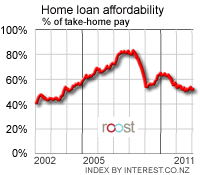 Rising house prices and interest rates combined in September to weaken home loan affordability to its worst level since December 2008, the BNZ Home Loan Affordability measure shows. The apparent recovery in the housing market and higher long term interest rates are adding to pressure on affordability caused by modest income growth and rising unemployment, the monthly measure calculated by Interest.co.nz found. The BNZ Home Loan Affordability measure for all of New Zealand showed the proportion of a single median after tax income needed to service an 80% mortgage on a median house rose by 1 percentage point to 59.7%, its worst level since December 2008.
Rising house prices and interest rates combined in September to weaken home loan affordability to its worst level since December 2008, the BNZ Home Loan Affordability measure shows. The apparent recovery in the housing market and higher long term interest rates are adding to pressure on affordability caused by modest income growth and rising unemployment, the monthly measure calculated by Interest.co.nz found. The BNZ Home Loan Affordability measure for all of New Zealand showed the proportion of a single median after tax income needed to service an 80% mortgage on a median house rose by 1 percentage point to 59.7%, its worst level since December 2008.
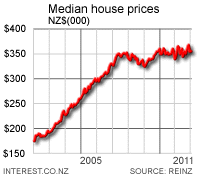 The median house price rose 0.9% in September to NZ$350,000 from NZ$347,000 in August and is now just 0.6% below its November 2007 peak of NZ$352,000. The average 2 year fixed mortgage rate, which has been among the most popular with borrowers in recent years, rose 8 basis points to 6.58% over the month and has now risen from an average 5.92% in February. Variable mortgage rates, meanwhile, have fallen in the last month 6.08%, meaning some borrowers may have chosen to go variable rather than fixed to improve their immediate affordability. Meanwhile, median incomes rose 1.7% in the last month "Affordability continues to worsen as interest rates rise and at some stage the housing market is going to run out breath," Interest.co.nz Editor Bernard Hickey said. "Mortgage rates have risen again through October and incomes remain flat," Hickey said. "Housing market activity will struggle to expand much over the next year as affordability approaches the worst levels seen in early 2008 and interest rates head back towards 8%," he added.
The median house price rose 0.9% in September to NZ$350,000 from NZ$347,000 in August and is now just 0.6% below its November 2007 peak of NZ$352,000. The average 2 year fixed mortgage rate, which has been among the most popular with borrowers in recent years, rose 8 basis points to 6.58% over the month and has now risen from an average 5.92% in February. Variable mortgage rates, meanwhile, have fallen in the last month 6.08%, meaning some borrowers may have chosen to go variable rather than fixed to improve their immediate affordability. Meanwhile, median incomes rose 1.7% in the last month "Affordability continues to worsen as interest rates rise and at some stage the housing market is going to run out breath," Interest.co.nz Editor Bernard Hickey said. "Mortgage rates have risen again through October and incomes remain flat," Hickey said. "Housing market activity will struggle to expand much over the next year as affordability approaches the worst levels seen in early 2008 and interest rates head back towards 8%," he added. 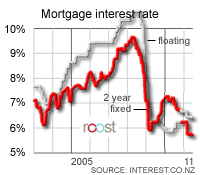 Affordability hit its worst level of 83.4% in March 2008 just after house prices peaked and 2 year mortgage rates were close to 10%. Many home buyers jumped in March, April and May of this year to take advantage of lower interest rates and look for bargains, which improved the number of houses sold and stabilised prices. But short term mortgage interest rates flattened out in late March and longer term mortgage rates began to rise in line with rises on wholesale markets and higher local term deposit rates. Affordability is increasingly out of reach for most home buyers on a single income. The threshold proportion of after tax income considered prudent to sustainably own a house is around 40%. Anything above that is starting to become unaffordable.
Affordability hit its worst level of 83.4% in March 2008 just after house prices peaked and 2 year mortgage rates were close to 10%. Many home buyers jumped in March, April and May of this year to take advantage of lower interest rates and look for bargains, which improved the number of houses sold and stabilised prices. But short term mortgage interest rates flattened out in late March and longer term mortgage rates began to rise in line with rises on wholesale markets and higher local term deposit rates. Affordability is increasingly out of reach for most home buyers on a single income. The threshold proportion of after tax income considered prudent to sustainably own a house is around 40%. Anything above that is starting to become unaffordable. 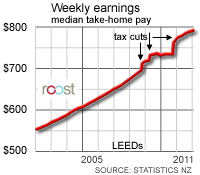 Affordability for the typical first-home-buyer also deteriorated in September. The proportion of a single after tax pay needed to buy a first quartile house rose to 51.6% from 50.1% in August. This is the highest level since November 2008. The first quartile house price rose in September to NZ$250,000 from NZ$245,000 in August. This measure is for a median income earner aged 25-29 buying a first quartile home. Interest.co.nz thinks the "˜affordable' threshold is 40% for such a home buyer. Meanwhile, affordability for households with more than one income also deteriorated and are now back to levels seen at the end of 2008.
Affordability for the typical first-home-buyer also deteriorated in September. The proportion of a single after tax pay needed to buy a first quartile house rose to 51.6% from 50.1% in August. This is the highest level since November 2008. The first quartile house price rose in September to NZ$250,000 from NZ$245,000 in August. This measure is for a median income earner aged 25-29 buying a first quartile home. Interest.co.nz thinks the "˜affordable' threshold is 40% for such a home buyer. Meanwhile, affordability for households with more than one income also deteriorated and are now back to levels seen at the end of 2008. 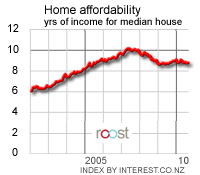 This measure of a "˜standard typical household' found the proportion of after tax income needed to service the mortgage on a median house rose to 39.1% in September from 38.5% in August. This measure assumes one median male income, half a median female income aged 30-35 and a 5 year old child that receives Working for Families. This is the worst level of standard household affordability since November last year and significantly above the 35% trough seen in January, February and March when buyer demand returned to the housing market. Any level over 40% is considered unaffordable for a household. Our measure of a "˜standard first-home-buyer household' found the proportion of after tax income needed to service the mortgage on a first quartile home rose to 24.4% in September from 23.6% in August. This compares with the trough of 22% in January, February and March when some first-home-buyers returned to the market. This measure peaked at 35% in July 2007. This measure assumes a first home buyer household includes a median male income and a median female income aged 25-29 with no children. Any level over 30% is considered unaffordable in the longer term for such a household. Southland remains the most affordable region for home buyers with a standard affordability measure of 35.3%, while the Central Otago Lakes (Wanaka and Queenstown) is the least affordable on 74.4%. Auckland sits at 72.8%, Wellington at 59.8% and Christchurch at 54.9%. Here is our measure of the ratio of house prices to household income.
This measure of a "˜standard typical household' found the proportion of after tax income needed to service the mortgage on a median house rose to 39.1% in September from 38.5% in August. This measure assumes one median male income, half a median female income aged 30-35 and a 5 year old child that receives Working for Families. This is the worst level of standard household affordability since November last year and significantly above the 35% trough seen in January, February and March when buyer demand returned to the housing market. Any level over 40% is considered unaffordable for a household. Our measure of a "˜standard first-home-buyer household' found the proportion of after tax income needed to service the mortgage on a first quartile home rose to 24.4% in September from 23.6% in August. This compares with the trough of 22% in January, February and March when some first-home-buyers returned to the market. This measure peaked at 35% in July 2007. This measure assumes a first home buyer household includes a median male income and a median female income aged 25-29 with no children. Any level over 30% is considered unaffordable in the longer term for such a household. Southland remains the most affordable region for home buyers with a standard affordability measure of 35.3%, while the Central Otago Lakes (Wanaka and Queenstown) is the least affordable on 74.4%. Auckland sits at 72.8%, Wellington at 59.8% and Christchurch at 54.9%. Here is our measure of the ratio of house prices to household income.

We welcome your comments below. If you are not already registered, please register to comment.
Remember we welcome robust, respectful and insightful debate. We don't welcome abusive or defamatory comments and will de-register those repeatedly making such comments. Our current comment policy is here.